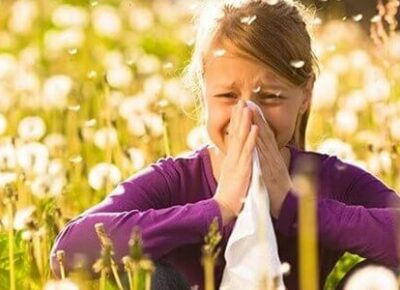Allergy Season Is Here!
We love these beautiful flowers at the entrance of our office – they are a sure sign that Spring is here! Unfortunately, this also means allergy season is here! Runny nose, sneezing, itchy eyes? Check out these tips to help you and your little one get through this allergy season.
WHEN TO SUSPECT AN ALLERGY
Some allergies are easy to identify by the pattern of symptoms that invariably follows exposure to a particular substance. But others are more subtle and may masquerade as other conditions. Here are some common clues that could lead you to suspect your child may have an allergy.
- Recurrent red, itchy, dry, sometime scaly rashes in the creases of the skin, wrists, and ankles.
- Repeated or chronic cold-like symptoms – that last more than a week or two, or develop at about the same time every year. These could include a runny nose, nasal stuffiness, sneezing and throat clearing.
- Nose rubbing, sniffling, snorting, sneezing and itchy, runny eyes.
- Itching or tingling sensations in the mouth and throat. Itchiness is not usually a complaint with a cold, but it is the hallmark of an allergy problem.
- Coughing, wheezing, difficulty breathing, and other respiratory symptoms. Coughing may be an isolated symptom; increases at night or with exercise are suspicious for asthma.
- Repeated ear or sinus infections or persistent middle ear fluid associated with nasal symptoms
- Recurrent episodes of abdominal pain following ingestion of a particular food.
COMMON ALLERGENS ON THE HOME FRONT
- Dust (contains dust mites, particles from other allergens such as pollen, mold and animal dander as well as irritants).
- Pollen (trees, grasses, weeds)
- Fungi (including molds too small to be seen with the naked eye)
- Furry animals (cats, dogs, guinea pigs, gerbils, rabbits, and other pets)
- Latex (household articles such as rubber gloves and toys, balloons)
- Foods (cow’s milk, eggs, peanuts, tree nuts, soy, wheat, fish and shellfish)
HOW TO MANAGE ALLERGIC NASAL SYMPTOMS
- Many children are allergic to pollen and mold, both of which are found everywhere outdoors and cannot be completely avoided.
- It’s helpful to use air conditioners, where possible, to reduce exposure to pollen in both your home and your car. Remain indoors when lawn is mowed. Avoid playing in fields of tall grass if allergic to grass. Outdoor mold levels are highest in the spring and late summer, particularly around areas of decaying vegetation. Children with allergies to molds should avoid playing in piles of dead leaves in the fall. Indoor exposure can occur from mildew as a result of water intrusion problems or elevated levels of moisture (e.g. bathrooms, use of humidifiers)
- Dust mites congregate where moisture is retained and food for them (human skin scales) is plentiful. They are especially numerous in upholstered furniture, bedding and rugs. Padded furnishings such as mattresses, box springs, pillows and cushions should be encased in allergen-proof, zip-up covers, which are available through catalogs and specialized retailers. Wash linens weekly and other bedding such as blankets, every 2 to 3 weeks in hot water (minimum temperature to kill mites is 130 degrees, so care must be taken to avoid scald burns when washing bedding if young children are present in the home). Pillows should be replaced every 2 to 3 years.
MEDICATIONS TO SUPRESS SYMPTOMS
Your child’s allergy treatment should start with your pediatrician, who may refer you to a pediatric allergy specialist for additional evaluations and treatments.
- Antihistamines – Ones taken by mouth can help with itchy watery eyes, runny nose and sneezing, as well as itchy skin and hives. Some types may cause drowsiness. Nose sprays that contain an antihistamine are also available and can be helpful, but should not be used more than three days.
- Decongestants – Help with stuffy nose.
- Nasal Corticosteroids – Highly effective for allergy symptom prevention and are widely used to stop chronic symptoms. Safe to use in children over long periods of time. Must be used daily.
- Allergy Immunotherapy – Immunotherapy, or allergy shots, may be recommended to reduce your child’s sensitivity to airborne allergens. Not every allergy problem can or needs to be treated with allergy shots, but treatment of respiratory allergies to pollen, dust mites, cat and dog dander, and outdoor molds is often successful if avoidance and medications are not effective. Allergy shots help decrease the need for daily medication.
- Ask your doctor about additional therapies.
